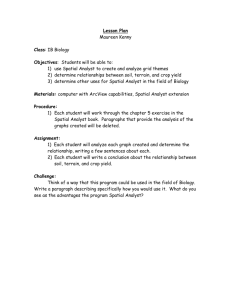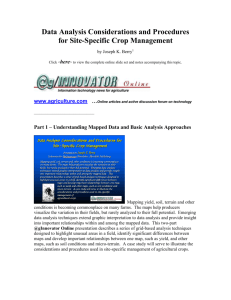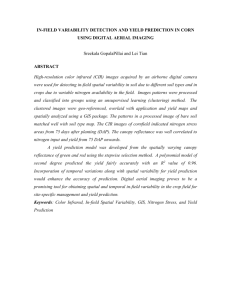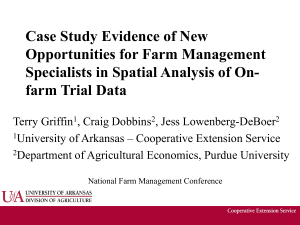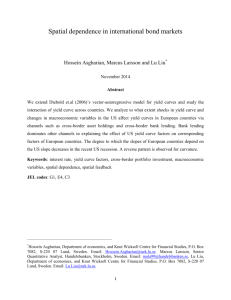Part 2 - BASIS website
advertisement
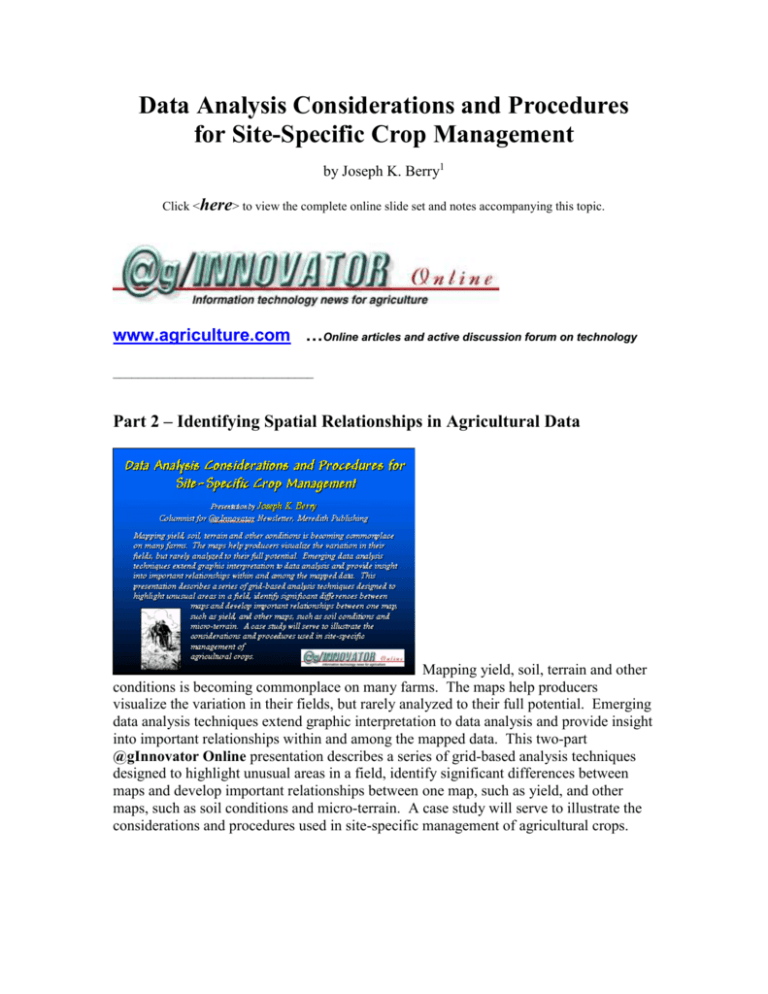
Data Analysis Considerations and Procedures for Site-Specific Crop Management by Joseph K. Berry1 Click <here> to view the complete online slide set and notes accompanying this topic. www.agriculture.com …Online articles and active discussion forum on technology ________________________________ Part 2 – Identifying Spatial Relationships in Agricultural Data Mapping yield, soil, terrain and other conditions is becoming commonplace on many farms. The maps help producers visualize the variation in their fields, but rarely analyzed to their full potential. Emerging data analysis techniques extend graphic interpretation to data analysis and provide insight into important relationships within and among the mapped data. This two-part @gInnovator Online presentation describes a series of grid-based analysis techniques designed to highlight unusual areas in a field, identify significant differences between maps and develop important relationships between one map, such as yield, and other maps, such as soil conditions and micro-terrain. A case study will serve to illustrate the considerations and procedures used in site-specific management of agricultural crops. Mapped data is graphically summarized by a “histogram” plot that depicts the number of grid cells (Y axis) having values that fall within small intervals of the data range (X axis). 2D and 3D displays of the data show the precise geographic location for each data value. A “scattergram” plots the data values in two maps layers—sort of a two histograms at once—and graphically shows the correlation between the maps. The pattern of points in a scattergram can be mathematically summarized into a prediction equation. Once a prediction equation is known it can be used to estimate what one variable might be given another (or set of others). In this example, the amount of phosphorous in the topsoil was used to predict the amount in the sub-soil. While the predictions were very good for the NE-central portion of the field (left-side of the main figure), they were not good for the rest of the field. However, the spatial pattern of the error (lower-right of the main figure) shows that the model over predicts along the west side of the field and tends to under predict along the northern side. This spatial distribution of error is used to reconstruct equations for two areas. Use of the three prediction equations within the appropriate areas creates good predictions across the entire field. This iterative procedure is termed “spatial trees” and utilizes the spatial information within data sets. If good prediction equations can be developed (i.e., yield predictions based on soil nutrients, terrain, etc) they can be used to determine the optimal combination of factors. For example, early spring soil samples can be used to create maps of current nutrient levels that are used to “solve” the yield equation for each grid cell—this establishes the “no action” yield level. An optimization technique can be used to iteratively add more nutrients until the cost of the fertilizer program approaches or equals the marginal revenue of the increased yield. In essence, the analysis is similar to having a comprehensive set of research trials for all of the unique conditions within the field. While this “spatial data mining” approach to precision farming is in its infancy, the approach forms the basis for many geo-business applications in other disciplines. Terrain is an important factor affecting crop production. Spatial analysis techniques are available to determine slope, orientation (aspect)roughness and surface flows. Sequencing several spatial analysis operations forms a GIS model. This model, consisting of five commands generates an erosion potential map based on the relative slope and surface flow conditions at each grid location—steep areas with lots of uphill locations contributing water is denoted as high erosion potential. The erosion potential model can be extended to determine potential for sediment loading. This model considers the intervening erosion potential of uphill locations to establish a variable-width buffer around sensitive streams. GIS data and spatial analysis techniques are increasingly being used to add real-world considerations to environmental policy and regulations. The grid-based analysis “toolbox” provides a new perspective on research and management in any land-based discipline. Agriculture’s ties to the land invariably ties it to this new technology. While maps and cartographic processing isn’t part of crop production’s legacy, its future is part of the spatial revolution. For more information on the topics discussed in this presentation see http://www.innovativegis.com/basis/pfprimer/ for an online text sponsored by @gInnovator. A case study of data analysis in precision farming will be apprearing in future issues of the @gInnovator Newsletter, For general information and an active discussion forum on precision farming see http://www.agriculture.com/technology/. __________________ These @gInnovator Online materials are based on an invited presentation for the Agriculture Discipline Forum, MidAmerica GIS Symposium on “Strengthening theGrowing Geodata Community,” Osage Beach, Missouri, May 14-18, 2000. Data Analysis Considerations and Procedures for Site-Specific Crop Management 1 Joseph K. Berry, Columnist for @gInnovator Newsletter, Meredith Publishing President, Berry and Associates // Spatial Information Systems 2000 South College Avenue, Suite 300, Fort Collins, CO 80525 Phone: 970-215-0825 Email: jberry@innovativegis.com Website: www.innovativegis.com/basis Abstract Mapping yield, soil, terrain and other conditions is becoming commonplace on many farms. The maps help producers visualize the variation in their fields, but rarely analyzed to their full potential. Emerging data analysis techniques extend graphic interpretation to data analysis and provide insight into important relationships within and among the mapped data. This presentation describes a series of grid-based analysis techniques designed to highlight unusual areas in a field, identify significant differences between maps and develop important relationships between one map, such as yield, and other maps, such as soil conditions and micro-terrain. A case study will serve to illustrate the considerations and procedures used in site-specific management of agricultural crops. ___________________
